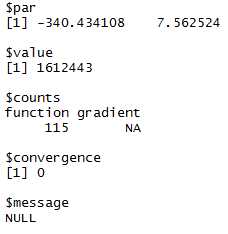标签:提示 遗传算法 function 贪心 inverse ext 向量 复杂 odi
第7章 优化:密码破译
优化简介:最优点(optimum),优化(optimization)
本章研究的问题:构建一个简单的密码破译系统,把解密一串密文当做一个优化问题。
优化方法:网格搜索(grid search),主要问题是1、步长的选择;2、维度灾难(Curse of Dimensionality):问题规模过大
optim函数:比网格搜索更快,可以通过已经计算出的信息推断出下一步的方向,同时对所有变量一起优化。(根据书中后文,可能的原理是根据导数得出下一步的进行方向,因为该函数对于不可导点的极值预测性能较差)(书中提到了参考凸优化的原理可以解决optim函数的问题,即绝对值误差优化)
岭回归(ridge regression):是一种特殊的回归,包含了正则化,与最小二乘法的区别在于其把回归系数本身当做误差项的一部分,这促使回归系数变小。
除了改变误差函数外,岭回归增加的唯一复杂度在于,引入超参数lambda,来权衡我们是希望有较小的平方误差,还是希望有较小的a和b以避免过拟合。(注:正则化算法中引入的该类参数称为超参数,需要根据实际需要或交叉验证选定最优的超参数)
#一个简单的岭回归的例子
ridge.error <- function(heights.weights, a, b, lambda){
predictions <- with(heights.weights, height.to.weight(Height, a, b))
errors <- with(heights.weights, Weight - predictions)
return(sum(errors ^ 2) + lambda * (a ^ 2 + b ^ 2))
}
lambda <- 1
optim(c(0,0),
function(x){
ridge.error(heights.weights, x[1], x[2], lambda)
})
#optim函数用法:1 把打算优化的参数封装在一个数值向量里(c(0,0))
# 2 传递的第二个参数是一个匿名函数,这个函数接受一个数值向量(x)作为输入,该数值向量包含了想要优化的目标变量
#结果说明:1 par 最优参数对
# 2 value 返回最优点时,误差具体值
# 3 counts 执行输入函数(function)和梯度(gradient)的次数
# 4 convergence 是否足够有把握找到最优点(一切没问题时该值为0,其他值可以在帮助文档中找到对应信息)
# 5 message 其他信息

用优化的思路解决密码破译问题:
随机优化:在可选的输入参数范围内,一定程度上随机的移动参数(保证移动参数的方向是误差减少的方向)。比较典型的有模拟退火算法、遗传算法以及马尔科夫链蒙特卡洛方法(Markov Chain Monte Carlo, MCMC)。本文中采用的算法是Metropolis方法
问题描述:
1、为每一种解密规则定义一个解密效果度量;
2、定义一个基于目前已知的解密效果最优的解密规则的算法,对它进行随机修改来生成一个新的解密规则;
3、定义一个算法,可以递进地生成破译效果逐渐变好的解密规则。
在此之前,完成密码的加密过程:
凯撒密码及其R语言实现:明文中的一个字母用另一个固定字母替代
english.letters <- c(‘a‘, ‘b‘, ‘c‘, ‘d‘, ‘e‘, ‘f‘, ‘g‘, ‘h‘, ‘i‘, ‘j‘, ‘k‘, ‘l‘, ‘m‘, ‘n‘,
‘o‘, ‘p‘, ‘q‘, ‘r‘, ‘s‘, ‘t‘, ‘u‘, ‘v‘, ‘w‘, ‘x‘, ‘y‘, ‘z‘)
caesar.cipher <- list()
inverse.caesar.cipher <- list()
for (index in 1:length(english.letters))
{
caesar.cipher[[english.letters[index]]] <- english.letters[index %% 26 + 1]
inverse.caesar.cipher[[english.letters[index %% 26 + 1]]] <- english.letters[index]
}
print(caesar.cipher)
加密函数:
apply.cipher.to.string <- function(string, cipher)
{
output <- ‘‘
for (i in 1:nchar(string))
{
output <- paste(output, cipher[[substr(string, i, i)]], sep = ‘‘)
}
return(output)
}
apply.cipher.to.text <- function(text, cipher)
{
output <- c()
for (string in text) {
output <- c(output, apply.cipher.to.string(string, cipher))
}
return(output)
}
apply.cipher.to.text(c(‘sample‘, ‘text‘), caesar.cipher)
1、解密效果的评价:解密出的词是有意义的,可以通过计算揭秘出的单词在词典中出现的概率来评价,将词组所有的词的概率相乘,就得到了词组的解密效果的评价指标(按照一般的逻辑,还应该有语法支持,不过这里并不讨论)
具体实现方式:Metropolis方法。首先从一个随机的解密规则开始,然后通过多次循环优化它,直到最后它就有可能成为一个正确的解密规则。
2、通过现有的解密规则得到一个新的解密规则:首先随机改变当前规则的一处,只有当新解密规则得到的解密串概率变高时,才接受新的解密规则(贪心优化),但是这个例子中,有可能一个“坏”的解密规则的解密串概率要大于“好”的,因此使用如下的优化方式:
设原解密规则为A,新解密规则为B
如果解密规则B解密出的解密串的概率大于解密规则A对应的解密串,那么我们用B代替A
如果解密规则B解密出的解密串的概率小于解密规则A对应的解密串,则用B代替A的概率为probability(T, B)/probability(T, A)
处理解密规则的工具
#产生随机加密规则
generate.random.cipher <- function()
{
cipher <- list()
inputs <- english.letters
outputs <- english.letters[sample(1:length(english.letters), length(english.letters))]
for (index in 1:length(english.letters))
{
cipher[[inputs[index]]] <- outputs[index]
}
return(cipher)
}
modify.cipher <- function(cipher, input, output)
{
new.cipher <- cipher
new.cipher[[input]] <- output
old.output <- cipher[[input]]
collateral.input <- names(which(sapply(names(cipher), function(key){cipher[[key]]}) == output))
new.cipher[[collateral.input]] <- old.output
return(new.cipher)
}
propose.modefied.cipher <- function(cipher)
{
input <- sample(names(cipher), 1)
output <- sample(english.letters, 1)
return(modify.cipher(cipher, input, output))
}
弱化版的贪心算法:计算probability(T, B)/probability(T, A),再把它与一个0~1的随机数比较,若随机数大,就更换当前规则,否则不变
#加载词典
load(‘ML_for_Hackers/07-Optimization/data/lexical_database.Rdata‘)
#计算文本概率的函数
one.gram.probability <- function(one.gram, lexical.database = list())
{
lexical.probability <- lexical.database[[one.gram]]
#R语言中最小的浮点数是.Machine$double.eps
if (is.null(lexical.probability) || is.na(lexical.probability))
{
return(.Machine$double.eps)
}
else
{
return(lexical.probability)
}
}
#对数变换(为了使结果稳定)
log.probability.of.text <- function(text, cipher, lexical.database = list())
{
log.probability <- 0.0
for (string in text)
{
decrypted.string <- apply.cipher.to.string(string, cipher)
log.probability <- log.probability + log(one.gram.probability(decrypted.string, lexical.database))
}
return(log.probability)
}
#单步Metropolis方法
metropolis.step <- function(text, cipher, lexical.database = list())
{
proposed.cipher <- propose.modefied.cipher(cipher)
lp1 <- log.probability.of.text(text, cipher, lexical.database)
lp2 <- log.probability.of.text(text, proposed.cipher, lexical.database)
if(lp2 > lp1)
{
return(proposed.cipher)
}
else
{
a <- exp(lp2 - lp1)
x <- runif(1)
if (x < a)
{
return(proposed.cipher)
}
else
{
return(cipher)
}
}
}
明文与加密:
decrypted.text <- c(‘here‘, ‘is‘, ‘some‘, ‘sample‘, ‘text‘) encrypted.text <- apply.cipher.to.text(decrypted.text, caesar.cipher)

解密并保存结果:
set.seed(1)
cipher <- generate.random.cipher()
results <- data.frame()
number.of.iterations <- 50000
for (iteration in 1:number.of.iterations)
{
log.probability <- log.probability.of.text(encrypted.text, cipher, lexical.database)
current.decrypted.text <- paste(apply.cipher.to.text(encrypted.text, cipher), collapse = ‘ ‘)
correct.text <- as.numeric(current.decrypted.text == paste(decrypted.text, collapse = ‘ ‘))
results <- rbind(results,
data.frame(Iterations = iteration,
LogProbability = log.probability,
CurrentDecryptedText = current.decrypted.text,
CorrectText = correct.text))
cipher <- metropolis.step(encrypted.text, cipher, lexical.database)
}
write.table(results, file = ‘chapter07_results.csv‘, row.names = FALSE, sep = ‘\t‘)
由于这种算法度量的是每一个单词是否是一个真正的英文单词,而不考虑连接起来是否通顺,即是否符合语法。这提示了要注意优化问题的复杂性:优化算法得到的最优结果不一定是想要的结果,解决优化问题时不能完全离开人工监督。
其他问题:
首先,Metropolis方法是一个随机优化算法。我们选择的随机种子是1,如果选择了一个不好的随机种子,可能需要执行亿万次循环才能得到正确的解密规则;
其次,Metropolis方法总是乐于放弃好的解密规则,因为这是一个非贪心算法。正因为如此,如果观察足够的时间,会发现它放弃了“真正”的解密规则。这种问题成为随机扰动。
解决这种随机扰动问题有一些方法:
1、模拟退火方法:随着循环次数增多,越来越不可能接受没有变好的规则(即越来越贪心);
2、接受这种随机性,但是给出的结果不是一个确定的方案,而是一组方案的概率分布。但这种方法只适用于数值型变量的问题。
标签:提示 遗传算法 function 贪心 inverse ext 向量 复杂 odi
原文地址:http://www.cnblogs.com/gyjerry/p/5595187.html